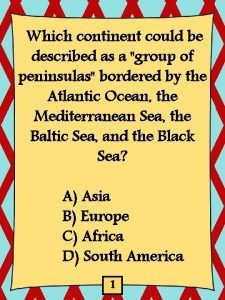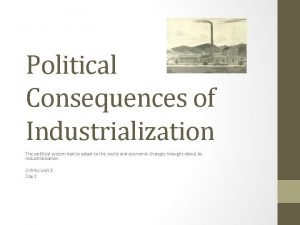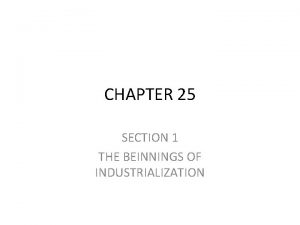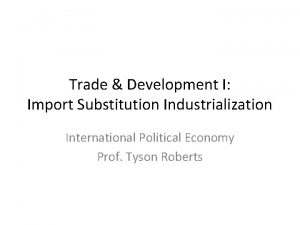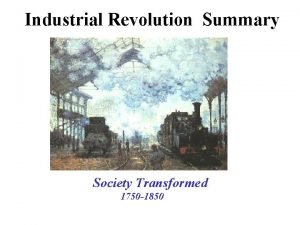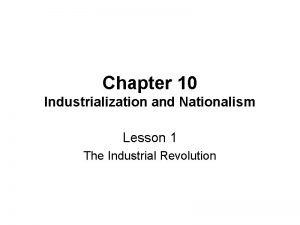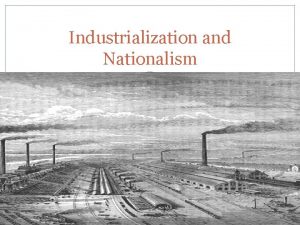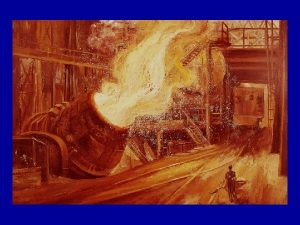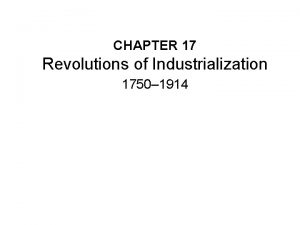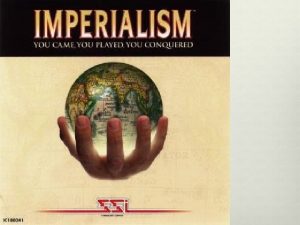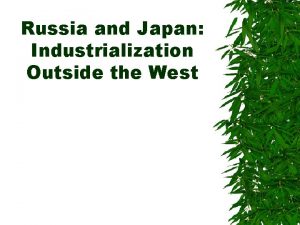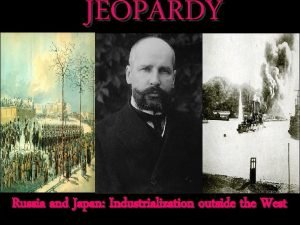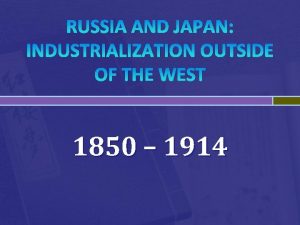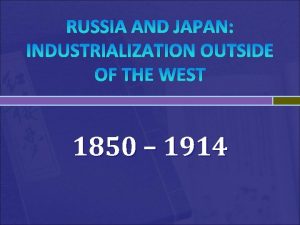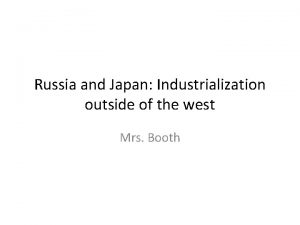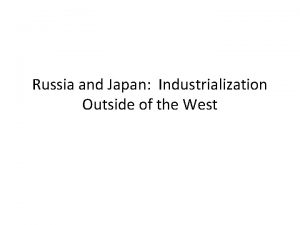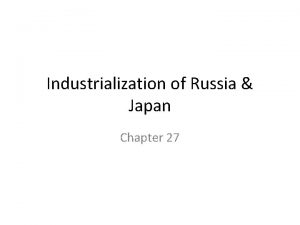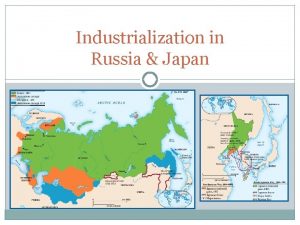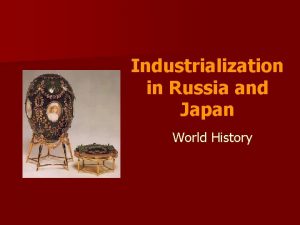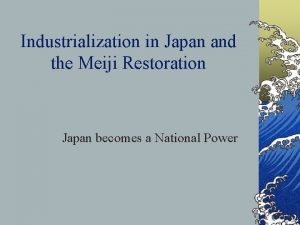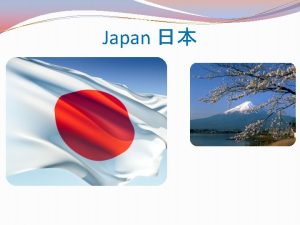Russia Japan Industrialization Outside the West Compare the






























- Slides: 30

Russia & Japan: Industrialization Outside the West Compare the role of Industrialization


Analyze the Document…

Crimean War( Russia’s on the Right)

Similarities Ø Ø Ø Maintained economic and political independence during the West’s century of power Prior experience of imitation Knew that learning from outsiders could be profitable and need not destroy their native cultures Improved their political effectiveness during the 17 th & 18 centuries Used the state to sponsor changes (in the West change was initiated by private businesses



Comp: Russian and Japanese Industrialism Similarities Differences Both led by nationalism in response to embarrassments (Crimean War/Opening to U. . S Matthew Perry in Edo) Both had prior imitation experience Both will develop industrial infrastructure( including militarism, imperialism, railroads, coal, textile factories) Both will wage wars of expansion ( Russo. Ottoman Wars, Sino-Japanese Wars and eventually Russo-Japanese war) Increased literacy for industrialization (including women) Both will establish political reforms ( Duma/Diet) Both will dissolve old feudal ties Both will have central authoritarian statesponsorship of industry Japan more homogeneous because of isolation, Russia more heterogeneous making pattern of nationalism more difficult Russia’s previous “westernization” under Peter the Great made it eventually dependent on foreign investment while Japan utilized zaibatsu to industrialize without much foreign help ( advisors and schooling but not investments) Japanese nationalism will solidify military power base after samurai wars while Russian reforms continue due to enlightened and communist ideas ( Decembrist uprising, 1905 rebellion and Russian Revolution 1917 due to unresolved social conflicts) Prior neo-Confucian ideology of Japan had social and economic benefits while the terrible conditions of serfdom and anti-Semitism in pale settlements slowed the pace of growth of Russification ( getting all of Russia to adhere to nationalistic homogeneity)

S. A. Q: Answer, Cite(Evidence), Explain ( analysis) Ø The Japanese and Russians were both embarrassed and shamed into industrialization through warfare. The Russians were soundly defeated after the Crimean War while the Japanese were opened up through American Admiral Matthew Perry at the port of Edo. Their seeming lack of industrial military technologies forced Russia and Japan to sign unequal treaties and force their consolidated governments into industrial reform movements. Ø Differences between Russian and Japanese industrialization was that Japans homogeneity facilitated nationalist consolidation and made industrialization more efficient while Russia’s heterogeneity created class struggles and hindered the development of nationalists industrialization. Japan’s Zaibatsu went to Western schools to learn about banking and industry and model during the Mejii restoration while Russia's attempt at nationalist reforms ( Russification) led to pogroms of Jewish populations and Marxist strikes in industrial towns. A united Japan had an easier period having been isolated since 1686 while Russia diversity hindered their development with different groups wanting different things from industrialism. Ø The “West” was different from Japan and Russian industrialization having both done it earlier and having private business holdings finance industrialization. The Mejii restoration and Romanovs were state sponsored industrialism while the West had business industries finance private monies into a competitive atmosphere. While Russia will be the 4 th largest steel and 2 nd in oil, the “West” was still drastically ahead of Russia and Japan in terms of economy and military industry with the U. S even brokering a peace agreement between Russia and Japan in the Russo-Japanese War 1904 -1904

More similarities Ø Ø Ø Ø Expansionist Literacy increases Not much reform or industrialization the first half of 19 th century Tensions between traditionalists and reformist intellectuals Extensive railroad network created New parliaments created Imitated West but retained identity Centralized authoritarian states

Female labor (Cultural similarities: Doc 3, and 7) Governmental Promotion of Manufacturing ( Political Similarities : doc, 1, 2, 6) Differences in raising capital (national banks in Japan doc 2, “influx in foreign capital” doc 1 Differences in response to labor conditions: Russia Aggressively against and striking (doc 4 and 7) while Japan did not (3 and 5)

P. O. V: Document 1 with the secret nature of the letter and its reliability as evidence of the motivations and character of Russian industrialization. Document #3 the veracity (factual nature) of the evidence by a “foreign” photographer of Japanese working conditions. In Document #5 the reliability of evidence of oral histories recorded a half century after the period of investigation. Synthesis linking To another time, region Or theme

Defying the Odds Stories of Russia & Japan do not fit the patterns of Western imperialism Ø Common Characteristics— imitation, understood benefits of borrowing, political effectiveness Ø Result? Clashing global spheres Ø l (Russo-Japanese War)

Russia Before Reform Ø Increasingly conservative to prevent Western revolutionary ideas l l Ø Western fascination remained among scholars & artists l Ø Alexander I @ Congress of Vienna Nicholas I represses opponents, controls schools & newspapers Decembrist uprising Territorial expansion continues, particularly toward Ottomans

Economic & Social Problems Ø Conservatism results in stagnant economy & growing gap w/ West l Ø Inferiority made clear by Crimean War l Ø Profoundly agricultural & serf-based Russia defeated by British & French industrial arms Reform becomes essential to allow for economic growth in order to maintain military strength

1 of 2 Reform Era & Industrialization Reforms addressed needs but led to expanded grievances Ø Serfs emancipated in 1861 Ø l l Ø Land given to serfs, population & urban labor force grows Tsar & aristocracy maintained w/ no new political rights, traditional farming & ties to land continued w/ redemption payments Zemstvoes allow middle class to gain positions in local government, military begins to modernize, literacy increases although unevenly, women gain access to education & jobs

2 of 2 Reform Era & Industrialization Ø Limited construction of modern factories l l Ø Extended railroad network (trans-Siberian Railroad) Coal, steel, oil, textile industries expand Development largely result of foreign investment, protective tariffs, & size l Factories less technologically advanced

Japan: Change w/o Revolution

Final Decades of Shogunate Economy is proto-industrial & increasingly commercial Ø Intellectually… Ø l l l Ø Neo-Confucianism adds secularism & literacy, National studies add nationalism, Dutch studies add science & Western ideas Economy only stagnates toward mid-1800 s w/ feudalism & ricebased finances intact Inside Silk-reeling Mill

Challenge to Isolation Ø U. S. commodore Perry & superior military technology opened Japan to trade Ø Internal tension grew b/t factions appealing to emperor Ø Crisis peaks w/ samurai violence & Western response proving superiority

Political Change: Meiji Restoration Crisis addressed with Meiji restoration of emperor in 1868 & deeper political changes Ø Reform based on Western imitation Ø l l l Centralized power in imperial house Replaced feudalism & daimyos w/ parliament & limited democracy, bureaucracy drawn from civil service exams, appointed district officials Samurai class & tax system overhauled causing diverse effects

Industrial Revolution Ø Military reforms included in early efforts Ø State direction, private enterprise, & foreign advisors combine to create full-scale industrialization by 1900 l l Ø Banking, railroads, shipyards Zaibatsu Despite industrialization, Japan still disadvantaged globally w/ lack of resources & machinery

Social & Diplomatic Effects Ø Socially attempt to balance Western & Japanese ideas l l Ø Rapid population growth, but slows w/ greater industrialization Copied Western science & hygiene, while maintaining Japanese morality Diplomatically aggressive following model of imperialism & fulfilling resource needs l l Sino-Japanese War Russo-Japanese War

Strain of Modernization Ø Strains evident in urban living standards, intellectual identity crisis, & parliamentary clashes w/ emperor Ø Nationalism promoted to ease strain

The purpose of this secret letter to Tsar Nicholas II about the type of industrialism in Russia (Protectionist is government regulated vs free trade without government Intervention) he is encouraging the government’s regulation to compete against Europeans while in doc #2 while Count Okuma utilized governmental forces, they Raised private capital under Mejii regulations.

Document #3 along with #5 illustrates the conditions to which workers produced Various goods (like textiles here) and that there were no strikes (perhaps because Of improved lifestyles or favorable working conditions)

Documents 4 and 5 illustrate different responses to the working conditions while Workers in Russia (#4) engaged in strikes against the conditions in the factories, the Japanese (Doc #5) had quite favorable impressions ( although the recounting of life Among elderly workers may be tempered by time)

Document #6 (in response to Whittes’s secret letter in doc #1) is a quite favorable Of the state sponsorship of industrialism in Russia (perhaps grouped with 1, 2 for Japan about the improvements made. ). This is counter to Doc #7 illustrating the Terrible conditions for women in Russian factories detailing the physical force of Children and long working hours for women (reasoning for their strikes). This physician Is justifying their reasoning coupled that women had to augment (help finance) their Pay wit prostitution (this serves to shock the women’s suffrage organization perhaps With communist or socialists leanings).

Global Connections Ø Russia already global player, but more fully so after industrialization Ø Japan enters global affairs w/ imperialism & complex relations Ø Russia, Japan, & U. S. add to atmosphere of competition by 1914 l EX- Yellow Peril

Thesis Ø Russia and Japan defied the pattern of nineteenth-century European domination. By 1900, they launched significant industrialization and accomplished other changes that preserved their independence. Both achieved economic autonomy and were able to join in the imperialist scramble. There were differences between the two. Japan displayed more political flexibility than did Russia. Change in Russia increased internal strains and led to revolution. Japan, through its reforms, pulled away from the rest of east Asia; Russia continued expanding its influence in eastern Europe and central Asia. Among the characteristics common to the two nations in their maintenance of independence was their prior experience of cultural imitation, Japan from China and Russia from Byzantium and the West. They were able to learn without destroying their own cultures. Both also had improved their political effectiveness during the seventeenth and eighteenth centuries, a situation allowing the state to sponsor change
 Which number on the map represents the english channel?
Which number on the map represents the english channel? West side story vs romeo and juliet
West side story vs romeo and juliet Oost west noord zuid
Oost west noord zuid East is east and west is west
East is east and west is west Winds that blow over short distances are called
Winds that blow over short distances are called Old west vs new west
Old west vs new west West north west wind direction
West north west wind direction Lesson quiz 23-2 industrialization and nationalism answers
Lesson quiz 23-2 industrialization and nationalism answers Consequences of industrialization
Consequences of industrialization Chapter 25 section 2 industrialization
Chapter 25 section 2 industrialization Import substitution industrialization
Import substitution industrialization Result of industrialization
Result of industrialization Industrialization of continental europe
Industrialization of continental europe Industrialization
Industrialization Industrialization
Industrialization Industrialization spreads chapter 25 section 3
Industrialization spreads chapter 25 section 3 Industrialization and nationalism lesson 4
Industrialization and nationalism lesson 4 Chapter 10 industrialization and nationalism
Chapter 10 industrialization and nationalism What is industrialization
What is industrialization Industrialization (1865 to 1901 worksheet answers key)
Industrialization (1865 to 1901 worksheet answers key) Pools industrialization definition
Pools industrialization definition Chapter 17 revolutions of industrialization
Chapter 17 revolutions of industrialization Industrialization definition
Industrialization definition Imperialism and industrialization
Imperialism and industrialization American laws
American laws Social darwinism in the industrial revolution
Social darwinism in the industrial revolution Industrialization
Industrialization Chapter 9 section 3 industrialization spreads
Chapter 9 section 3 industrialization spreads Lesson 3 - big business and government
Lesson 3 - big business and government The beginnings of industrialization
The beginnings of industrialization -have strength to match the growth of industrialization
-have strength to match the growth of industrialization
